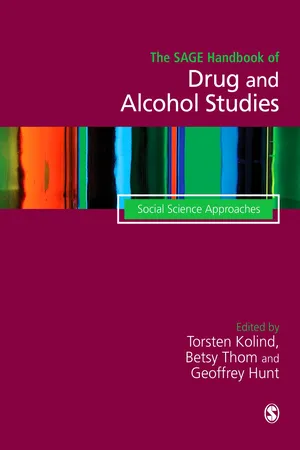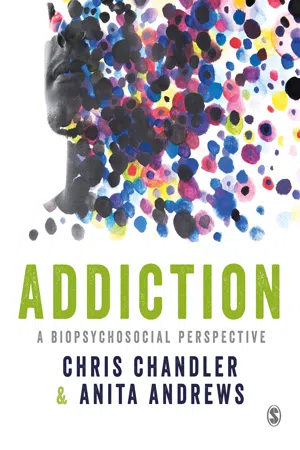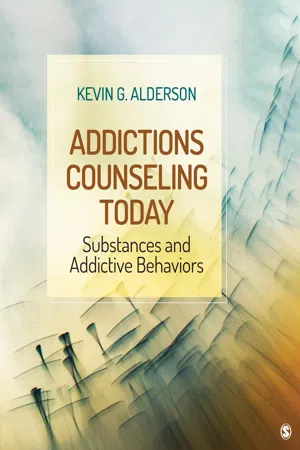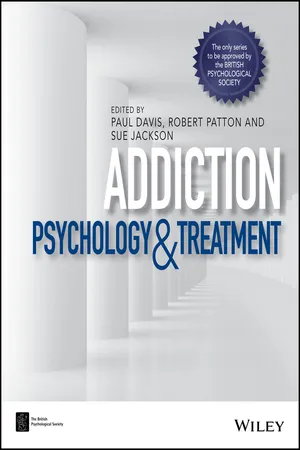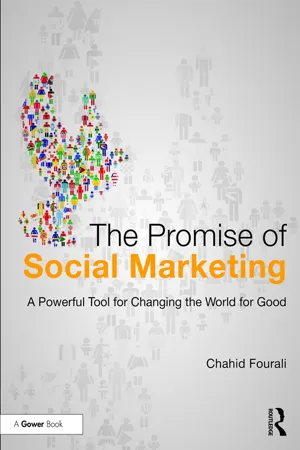Psychology
Theories of addiction
Theories of addiction in psychology encompass various perspectives on the causes and mechanisms of addictive behaviors. These theories include biological models, which focus on genetic and neurological factors, as well as psychological models, which emphasize the role of learning, motivation, and cognitive processes in addiction. Sociocultural theories also consider the influence of social and environmental factors on addictive behaviors.
Written by Perlego with AI-assistance
Related key terms
9 Key excerpts on "Theories of addiction"
- eBook - ePub
The SAGE Handbook of Drug & Alcohol Studies
Social Science Approaches
- Torsten Kolind, Betsy Thom, Geoffrey Hunt(Authors)
- 2016(Publication Date)
- SAGE Publications Ltd(Publisher)
Psychological formulations of addiction typically view the behaviour as serving some function for the individual, for instance, a desire for social belonging, euphoria or relief from negative emotions. Behaviourist theories focus on external contingencies driving forward addiction, whereas others focus more on individual vulnerabilities such as mental health, inadequate coping skills or cognitive deficits; still others, such as psychodynamic theories, focus more on universal but distorted unconscious developmental patterns. Inconsistencies between goals, thoughts, feelings and behaviours, also raises intriguing questions about the interplay of conscious, controlled responses, sometimes referred to as ‘explicit social cognition’, and non-volitional drives that are unconscious, automatic responses or so called ‘implicit social cognition’.Our current understanding of addiction tends to adopt elements from a number of theories and in this chapter we focus on: (i) psychodynamic thinking; (ii) behavioural theory; (iii) social learning theory; (iv) cognitive theory; (v) dual process perspectives; (vi) the role of personality and mental health; and (vii) neurobiological and neuropsychological markers. We then introduce addiction-specific models that integrate psychological thinking into an overall framework centred around: (i) motivation; (ii) excessive appetites; and (iii) relapse prevention.Psychodynamic Theories of addiction
Psychodynamic theories provided one of the earliest ways of thinking about addiction. Different schools of psychoanalytic thinking have different theories as to how the personality is shaped, psychopathology develops and change takes place. However, they all share a common belief that our current feelings, thoughts and experiences are affected by our early life experiences and that some of our mental activity is unconscious. Addiction is thought to relate to early experiences of deprivation or over-indulgence, which results in unmet attachment needs, disturbances in the sense of self and difficulties with drive and affect, self-care, dependency and need satisfaction. - eBook - ePub
Addiction
A biopsychosocial perspective
- Chris Chandler, Anita Andrews(Authors)
- 2018(Publication Date)
- SAGE Publications Ltd(Publisher)
addiction should be able to account for the key features of addiction including: individual susceptibility; its development and maintenance; how it is experienced physically and psychologically (features such as tolerance, craving, impulsive and compulsive use); and be able to suggest possibilities for treatment. Ideally a good theory should generate testable hypotheses. This is extremely challenging because it is very difficult to design studies in this field which accurately represent experiences in the real world (ecologically valid experiments). This is because in addition to societal and cultural impacts, addiction is experienced on an individual level, as a personal conflict, in individually triggering and personal environments. As a result of this complexity, most Theories of addiction help us to understand one part of the picture more clearly without necessarily adequately addressing the other parts. Although the different theories in this chapter are organised under different subheadings for clarity, it will become evident that there is substantial overlap between theories and between attempts to explain observations. Different theories may incorporate widely applicable observations and offer distinct but mutually supportive explanations. It is difficult to experimentally evaluate all levels of analysis simultaneously. The first section will provide a broad overview of the disease or biomedical model of addiction, briefly tracing its history through alcohol and opioids to the current conceptualisation of the ‘disease’. The inclusion of the disease model in a chapter on psychological Theories of addiction serves to illustrate the interrelationships between psychological processes and their biological underpinnings (see Chapter 3 for the neural systems involved). The next section will focus on theories which emphasise the role of choice and the influence of cognitive processes such as attention, perception and memory in driving addictive behaviour - eBook - ePub
- Maree Teesson, Wayne Hall, Heather Proudfoot, Louisa Degenhardt(Authors)
- 2013(Publication Date)
- Psychology Press(Publisher)
Theories of addiction:Causes andmaintenance ofaddiction 4Overview: Theories of addiction
In attempting to explain why people become dependent on drugs, theories tend to emphasize either psychobiological or psychosocial approaches. Psychobiological approaches include both neurobiological and genetic explanations of addictive behaviour. Psychosocial approaches focus on explanations that involve learning models and individual differences, usually while taking into account the cultural and environmental factors that make drug dependence more likely. There are a variety of theories regarding the question of why people become dependent on drugs, and it is likely that these are not mutually exclusive. It is clear that we need an approach that synthesizes these perspectives to have the greatest explanatory value (West, 2006).Physiological bases of addiction
Neuroscientific theories
Neuroscience with the aid of neuroimaging is gradually revealing how the brain changes as a consequence of the regular use of drugs. These changes suggest that chronic drug use produces persistent impairments in neurocognitive and motivational states (Carter, Capps, & Hall, 2009).Neuroscientific theories require an understanding of the effects of drugs on the brain. Box 4.1 outlines the actions of each of the major drug classes. Different drugs have different primary actions on the brain, but two major pathways – the dopamine reward system and the endogenous opioid system – have been implicated as being common to the effects of most drugs of dependence (Koob & Le Moal, 2008; Nutt, Robbins, Stimson, Ince, & Jackson, 2007).Dopamine reward system
Neuroimaging has identified the multiple brain systems that are affected by psychoactive drug use. It is hypothesized that changes in these systems may explain the behaviour of drug-addicted people, specifically, their loss of control and compulsive drug taking, and their difficulty in sustaining abstinence and avoiding relapse to drug use. The dopaminergic pathway has dense connections to the fore-brain and the higher cognitive centres of the frontal cortex. Although it is not the only neural system in the brain affected by drug abuse, changes in these pathways are considered to be central to the development and maintenance of addictive behaviour (Carter et al., 2009). - eBook - ePub
Addictions Counseling Today
Substances and Addictive Behaviors
- Kevin G. Alderson(Author)
- 2019(Publication Date)
- SAGE Publications, Inc(Publisher)
model. Over the past century, addiction models have flourished, but each has failed to build upon what was addressed earlier by other theories. Theory ought to inform treatment, and a good theory coexists with empirically validated treatments.The theories described in this chapter include the moral/choice model, biological/disease theories, psychological theories, family models, sociocultural theories, postmodern theories, and the biopsychosocial model. A brief discussion followed each theory with a look at the role of the counselor using each approach, the strengths of the approach, and its limitations.The moral/choice model was the first pervasive addiction theory, which stigmatized addicted individuals as it focused on their sinful nature. Eventually, this view morphed by some into viewing addicted individuals as people with free will who continued making bad choices despite their self-evident maladaptive behaviors.Chronologically, the ever-popular biological/disease theories followed, which fortunately helped remove the stigma as addicted individuals were now seen as ordinary people who experienced a disease comparable to others with physical diseases. Genetic and neuroscience research continues to support this view of addictions.Four psychological theories were considered, including the (a) psychodynamic theories that focus on clients’ pasts in explaining their addictions, (b) behavioral/learning theories that contend that addictions are learned behaviors that can be unlearned, (c) cognitive-behavioral theories that provide several reasons (i.e., cognitions) that perpetuate addictive behaviors, and (d) personality theories that purport that people become dependent because they have “addictive personalities.” Each theory helps explain the mystery of addictions.Other researchers and counselors subscribe to a family/systems theory perspective. In this approach, the “identified” client represents an endemic problem shared with other family members. The three predominant models that use a systems approach are the behavioral, family systems, and family disease models. Each model advocates different approaches for helping families improve and possibly heal from addiction (and other problems that originate from the family dysfunction). - eBook - ePub
Addiction
Psychology and Treatment
- Paul Davis, Robert Patton, Sue Jackson(Authors)
- 2017(Publication Date)
- Wiley-Blackwell(Publisher)
Part 1 Understanding the Psychology and Treatment of AddictionsPassage contains an image
1 Addiction: A Comprehensive Approach
JAMIE BROWN AND ROBERT WEST Cancer Research UK Health Behaviour Research Centre, University College London, UKCHAPTER OUTLINE
- 1.1 INTRODUCTION
- 1.2 EXISTING THEORIES
- 1.3 THE HUMAN MOTIVATIONAL SYSTEM
- 1.4 INTERNAL AND EXTERNAL SOURCES OF INFLUENCE
- 1.5 THE DYNAMICS OF THE SYSTEM
- 1.6 CHANGING DISPOSITIONS
- 1.7 TESTING THE THEORY
- SUGGESTIONS FOR FURTHER READING
- REFERENCES
1.1 INTRODUCTION
‘Addiction’ is a social construct which can be usefully defined as a chronic condition in which there is a repeated powerful motivation to engage in a rewarding behaviour, acquired as a result of engaging in that behaviour, that has significant potential for unintended harm. From this perspective, a broad conception of motivation is at the heart of addiction and requires any theory of addiction to be based on a comprehensive theory of motivation. This approach understands addiction can be driven by many different factors – physiological, psychological, environmental and social – and that it is not useful to focus on one particular factor to the exclusion of all others. PRIME theory aims to provide a conceptual framework within which the major insights provided by more specific theories of choice, self-control, habits, emotions and drives can be integrated.PRIME theory describes the motivational system as the set of brain processes that energize and direct our actions. The system can be usefully divided into five interacting but distinct sub-systems: (1) response execution; (2) impulses/inhibition; (3) motives (wants and needs); (4) evaluations (beliefs about what is good or bad); and (5) plans (self-conscious intentions). The response execution system co-ordinates what is happening at any given moment. The proximal influences on this are the impulses and inhibitions to perform particular responses. Motives can influence behaviour only through impulses and inhibitions, evaluations can do so only through motives, and plans must operate on either motives or evaluations. These can also each be influenced by the immediate internal or external environment. Important internal sources of influence include identity, self-control, drives and emotional states. - eBook - ePub
- Francis Pakes, Jane Winstone(Authors)
- 2013(Publication Date)
- Willan(Publisher)
New Scientist (2006), for a timeline), and the observations of the pleasures and problems associated with that use has led to the formulation of a number of key questions (Lindstrom 1992; Bickel and Potenza 2006):• Why do people begin to use drugs?• How and why does drug use escalate to misuse?• Why does this continue despite severe and negative consequences?• Why and how do people stop or modify their drug taking?• Why is addiction so difficult to treat?• Why is it so common for people to relapse after a period of abstinence or controlled use?• What is the relationship between addiction and multiple problem areas, particularly psychiatric disorders?Psychology makes a fundamentally important contribution to answering these questions; however, any understanding of addiction which stems from a psychological perspective has to consider that addiction is also a biological and social phenomenon, and this is referred to in the literature as the ‘biopsychosocial’ paradigm (Lindstrom 1992). This perspective argues that in theorising, assessing and intervening to address issues related to addictive behaviour (a possible), equal weighting should be given to each of these areas.The biopsychosocial paradigm hypothesises that addiction is about more than the sum of the individual parts of biology, psychology and the social dimension (Lende and Smith 2002). It has been pointed out by Orford (1990) that it has been difficult to gain an integration of the human sciences to address these issues. Separate disciplines tending to work within their own fields, and Chick (2002: 474) warns that ‘addiction science that is isolated will die out’. The need for insights from a variety of disciplines is essential, as Orford (1990: 211) argues: ‘Because of the existence of undisputed determinants of dependence in each of these three major areas of study, and because of its ubiquity and importance, dependence may be of particular significance in the study of human kind.’ - eBook - ePub
The Promise of Social Marketing
A Powerful Tool for Changing the World for Good
- Chahid Fourali(Author)
- 2016(Publication Date)
- Routledge(Publisher)
• Most theories apply to many psychological conditions (anger, anxiety, depression, etc.). So social marketers who feel that addiction may not be the primary factor they are dealing with may readjust the explanatory models for their own purposes.• Addiction theories are closely aligned to motivation theories making them very relevant to the task of behavioural change.• Social marketers have already started making use of addiction theories as demonstrated, for example, through the adoption of the trans-theoretical model by Andreasen (2006) and Hastings and Haywood (1991) as shown below.West and Brown (2013) classify the addiction theories for explaining behaviour under two labels: individual- or group-level explanations as shown in Figure 5.1 . We will take each level in turn and present it briefly. The reader who needs more details may like to refer to the references provided for each perspective, as there is little space for in-depth presentation. Note that the list of factors/influences presented below is compatible with those presented earlier, based on Schiffman et al. (2012) and Brassington and Pettitt (2006) with the difference being that there are several options presented to account for the psychological perspective.Individual-Level TheoriesFigure 5.1 Two main groups of theories for explaining maladaptive behaviourThe following is a brief introduction to each of the main individual-level theories. As stated earlier, the reader interested in a more detailed presentation can refer to the authors listed in each introduction. Table 5.1 - eBook - ePub
Drugs without the hot air
Making sense of legal and illegal drugs
- David Nutt(Author)
- 2020(Publication Date)
- UIT Cambridge(Publisher)
Chapter 9. What is addiction? Is there an “addictive personality”?
Using substances from outside the body to change our brain chemistry is something humans have always done, and the psychoactive effects created are similar to the changes we experience when we eat nice food or take exercise. For the majority of people the majority of the time, this doesn’t lead to compulsive behaviour – we remain in control, and pretty soon our brains return to their prior state. For a minority, however, drug use leads to drug abuse and addiction, just as a minority of people become addicted to food, gambling or sex. For these people, satisfying their cravings for whatever it is they’re addicted to becomes the most powerful source of motivation in their lives, overpowering every other need and often leading them to harm themselves and others.There are three elements that affect whether a person becomes addicted to a particular drug (Figure 9.1 ):Figure 9.1: The three elements that affect whether a person becomes addicted to a particular drug.1. Drug-related factors include how the drug reaches the brain, and what it does when it gets there. Tolerance and withdrawal also affect its addictiveness.2. Social factors include the availability and acceptability of using the drug, the prevalence of advertising, how the drug makes groups behave, and the economic and social costs.3. Personal and biological factors are those such as age, gender and genetics.In this chapter we look at the mechanisms of addiction, tolerance and withdrawal, and why certain people seem to have “addictive personalities”. (Chapter 4 has already examined some of the drug-related factors, which we explore in more detail in chapter 11 , and we cover the social factors in chapter 12 .)Addiction in history
Our understanding of addiction has increased as more drugs have become available, and as their role in society has changed. Until the 19th century, heavy drinking or use of other drugs wasn’t seen as a special category of behaviour, but as a sin of excess, similar to overeating – gluttony was a problem because you were eating too much , not because food itself was a bad thing. Although excessive use of drugs was seen as problematic, the majority of people usually didn’t have access to enough potent substances to have that problem. An exception was the † Gin Craze of the 18th - eBook - ePub
- Geri Miller(Author)
- 2014(Publication Date)
- Wiley(Publisher)
Chapter 2 Theories of Counseling Applied to Addiction TreatmentPersonal Reflections
Our view of counseling is a reflection of our personal views, our professional training, and the client populations with which we have worked. Each of us needs to find a theoretical framework that clearly reflects our approach to counseling. It is easy to be swayed by charismatic “teachers” and “fads” that come and go, but our clients deserve better than this. They deserve to know and experience our counseling approach shortly after they meet us. They deserve, whatever the theoretical framework, to be treated with respect and care for their dignity and their humanity as they are invited to heal from the addiction with which they struggle and the scars from it that they carry and have caused in others.My biggest difficulty in this area of theories and techniques has been in the translation of them into addiction counseling work. Note that not everyone in the counseling field respects addiction counseling as a specialty area. I myself have been told by influential professionals that “anyone, anywhere, anytime, can teach anything on addictions.” I believe that is a potentially dangerous philosophy that speaks to a lack of awareness of the unique dynamics of addiction counseling.Instead we need to take the general counseling theories and techniques and apply them to the addicted client in a way that is healing for the client, not being in denial of or enabling their addiction. In the revision of this chapter, I emphasize the application of these theories and techniques as they relate specifically to the addicted client. As I propose such approaches, I encourage the reader to remember to only use these applied techniques if they are helpful to the client. As I tell my students, “If you go to use a technique and it does not seem to be working, just stop it because both you and the client know it is not being effective.”
Learn about this page
Index pages curate the most relevant extracts from our library of academic textbooks. They’ve been created using an in-house natural language model (NLM), each adding context and meaning to key research topics.
